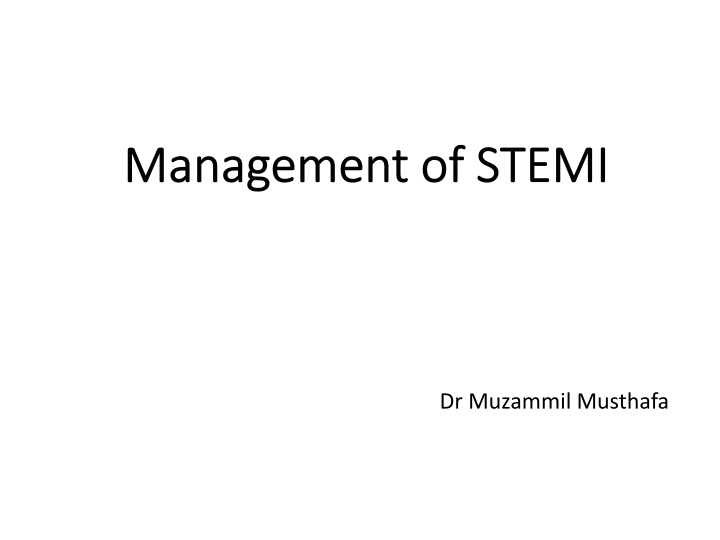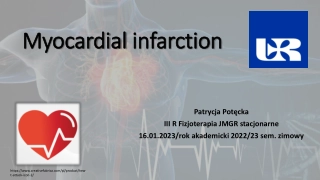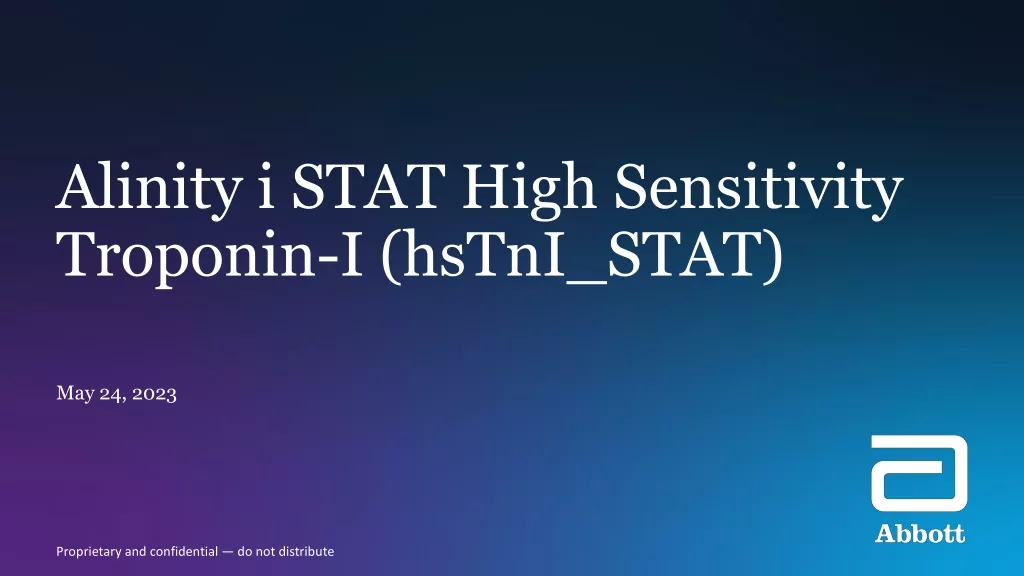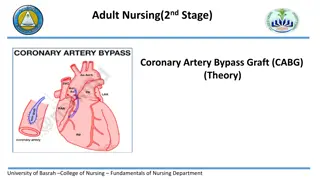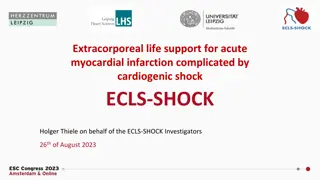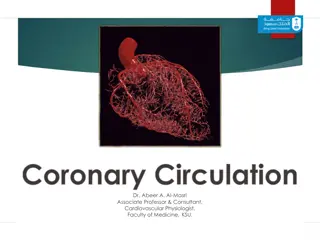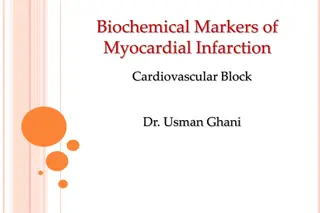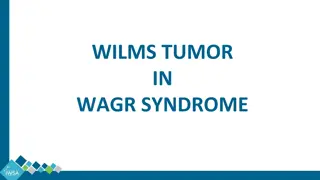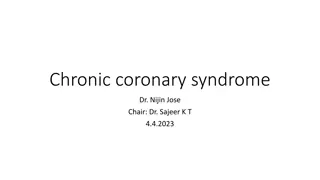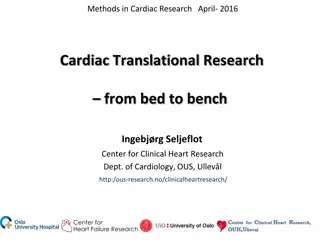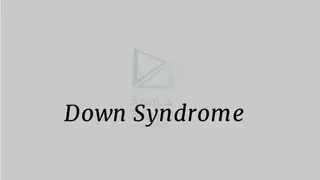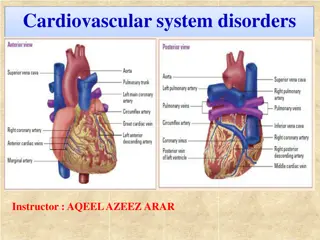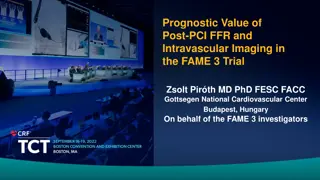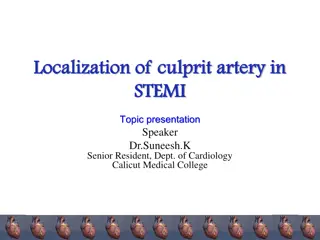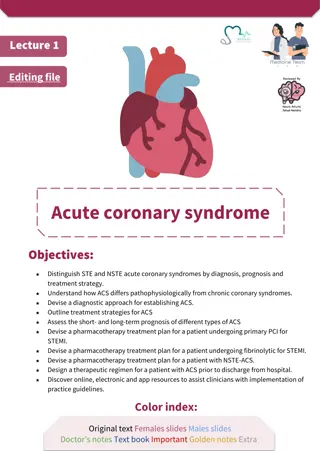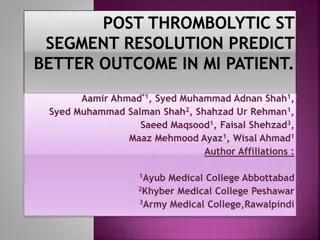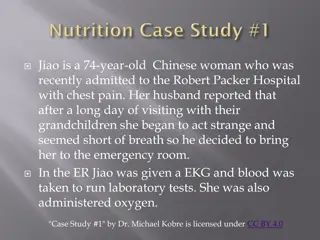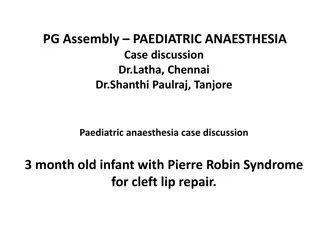Overview of Acute Coronary Syndrome and Myocardial Infarction
Acute Coronary Syndrome (ACS) encompasses a spectrum of conditions involving reduced blood flow in the heart. Ischemic Heart Disease (IHD) is a leading cause of mortality worldwide, with ST-elevation myocardial infarction (STEMI) being more common in younger men. Prompt diagnosis, treatment, and adherence to guidelines can improve outcomes and reduce mortality rates. Relief of pain, breathlessness, and anxiety is crucial, with interventions like morphine and oxygen therapy playing key roles in management.
Download Presentation

Please find below an Image/Link to download the presentation.
The content on the website is provided AS IS for your information and personal use only. It may not be sold, licensed, or shared on other websites without obtaining consent from the author.If you encounter any issues during the download, it is possible that the publisher has removed the file from their server.
You are allowed to download the files provided on this website for personal or commercial use, subject to the condition that they are used lawfully. All files are the property of their respective owners.
The content on the website is provided AS IS for your information and personal use only. It may not be sold, licensed, or shared on other websites without obtaining consent from the author.
E N D
Presentation Transcript
ACS Spectrum of conditions Abrupt reduction in blood flow through the coronary circulation Myocardial ischemia or infarction NSTEACS STEMI
Worldwide, IHD MC cause of death 1.8M annual deaths 20% of all deaths in Europe STEMI-more common younger > older Men > women Several studies highlighted fall in short term and long term mortality with use of reperfusion therapy,PCI,antithrombotic & secondary prevention Still mortality high 4-12%
AMI defined as an elevation of cardiac troponin values with necrosis in a setting consistent with myocardial ischaemia. For treatment strategies , it is usual to designate patients with persistent chest discomfort or other symptoms suggestive of ischaemia and ST-segment changes.
STEMI(universal definition) In the absence of LVH or LBBB J point greater than 0.1mv in 2 contiguous leads other than V2-V3,where the following cut off apply. >0.25-men <40 >0.20-men>40 >0.15-women Obscured LBBB Paced rhythm LV hypertrophy Brugada syndrome
Guidelines summarize and evaluate available evidence with the aim of assisting health professionals in selecting the best management strategies for an individual. However, the final decisions concerning an individual patient must be made by the responsible health professional in consultation with the patient and caregiver as appropriate.
RELIEF OF PAIN, BREATHLESSNESS AND ANXIETY Pain relief paramount importance Increase symphathetic activation Increase vasoconstricton Increase workload IV opiods Morphine But diminished effects of clopidogrel, prasugrel and ticagrelor Hypoxia oxygen indicated when SaO2 < 90% Anxiety relief by benzodiazepines
Cardiac arrest and unresponsive pts.. Many death VF Defibrillation equipment must Trained persons with BLS and ACLS Primary pci choice of treatment In pts with high clinical probability of coronary occlusions unresponsive pts coronary angiography is urgent But to exclude PE Drug Cva Resp failure
In patients with poor neurological outcome Late presentation to hospital >20m ACLS Non shockable rhythm Angiography and subsequent revascularisation poor outcome
Unconcious pts Targetted temp 32 36 C Hypothermia decreased effects of prasugrel, clopidogrel and ticagrelor Metabolic conversion of clopidogrel delayed.
Prehospital care Treatment Delays are common in management of STEMI To minimise delay-increase public awareness to recognise symptoms of AMI EMS-to diagnose STEMI should be <10 mins Following diagnosis-immediate activation of cath lab
PREHOSPITAL PREHOSPITAL CARE CARE
Occluded Artery TRIAL NEJM DEC 2006 RCT n-2166 stable patients persistent occlusion of the IRA 3 28 days after MI no clinical benefit from routine coronary intervention than with OMT
PRIMARY PCI RADIAL approach MATRIX TRIAL 8404 patients 30 days Less bleeding Vascular complications Need for transfusion RIVAL RIFLE STEACS
STENTINGDES over BMS Less need for repeated TVR Decreased ST COMFORTABLE AMI TRIAL
Deferred stentingdecreased MVO DANAMI 3 DEFER TRIAL 1215 pts RCT 42 months no superiority over stent implantation Thrombus aspiration TOTAL TRIAL NEJM APRIL 2015 10372 pts Increased risk of stroke
TOTAL REVASCULARISATION PRAMI TRIAL CULPRIT TRIAL Treatment of non IRA decreased adverse CV events IABP CRISP AMI TRIAL RCT 337 pts No reduction in infarct size
PERIPROCEDURAL PHARMACOTHERAPY DAPT+ P2Y12+ parentral AC Aspirin-150-300mg Clopidogrel-600mg Prasugrel 60mg LD f/b 10 mg OD Ticagrelor-180mg LD f/b 90 mg BD P and T Rapid onset of action Greater potency
Prasugrel C/I with >75 <60kg Stroke/TIA Ticagrelor Dyspnoea No structural or functional abnormalities Prasugrel and Ticagrelor Not used in Prior hemorrhages On OAC Mod severe LD
Cangrelor I/V p2y12 GP2B3A I As bail out therapy Large thrombus Slow or no reflow No role for intracoronary GP2B3AI
Parentral AC UFH Enoxaparin Bivalirudin No role for fondaparinaux potential harm
Routine post procedure AC not preferred Except with AF LV thrombus Mechanical valves Prophylaxis of VTE
Major predictors of mortalityMVO and infarct size MVO inadequate perfusion after opening of IRA Post procedure-TIMI <3 ST resolution post procedure <70% Myocardial blush grade 0 or 1
FIBRINOLYSIS Recommended within 12 hrs,if primary PCI cannot be done If time exceeds >3hrs from symptom onset ,better primary PCI No contraindications Prehospital fibrinolysis Metaanalysis (6 RCT) N-6434 Decreases mortality -17%
STREAM trial NEJM April 2013 RCT 1892 patients Presented within 3hrs; unable to undergo prmary pci TNK / PRIMARY PCI PCI between 6-24 hrs NO SIGNIFICANT DIFFERENCE BETWEEN PRIMARY ENDPOINTS (death or reinfarction) Increased risk of intracranial hemorrhages in fibrinolytic group
Fibrin specific agents preferred Antiplatelets and Anticoagulation No role for Prasugrel Ticagrelor GP2B3A inhibitors
Parentral anticoagulation Atleast 48 hrs Or upto 8 days ASSENT 3 TRIAL TNK f/b enoxaparin OR UFH RCT 6095 patients decreased 30 day mortality/ MACE
CABG In patients with Patent IRA but with unsuitable anatomy for PCI Cardiogenic shock Large myocardium at jeopardy
AMBULATION By day 1 ambulation begun In patients with Hypotension Arrythmias Heart failure Once stabilized
Low risk patients- 48-72 hrs discharged PAMI 11 CRITERIA LOW RISK <70 yrs LVEF >45% 1/2 vessel disease Succesful PCI No arrhythmias ZWOLLE PRIMARY PCI INDEX
Special issues Anticoagulation OAC relative C/I Triaged for pci Given Aspirin Clopidogrel Avoid GP2B3A Prasugrel / ticagrelor
Triple therapy 6 month After 6 months OAC+ A/C After 1 year OAC only
Renal dysfunction Dose modification necessary eGFR 30-40% worse prognosis
